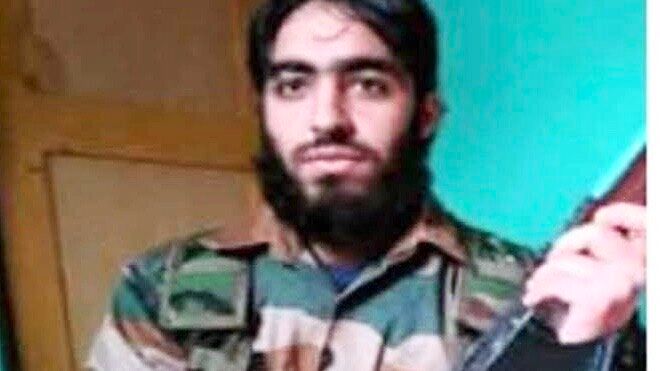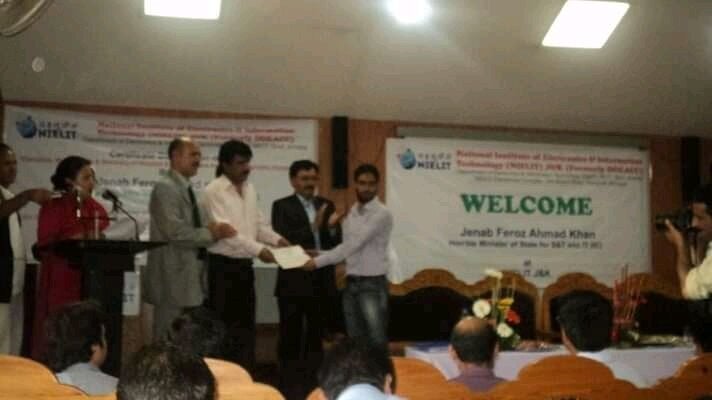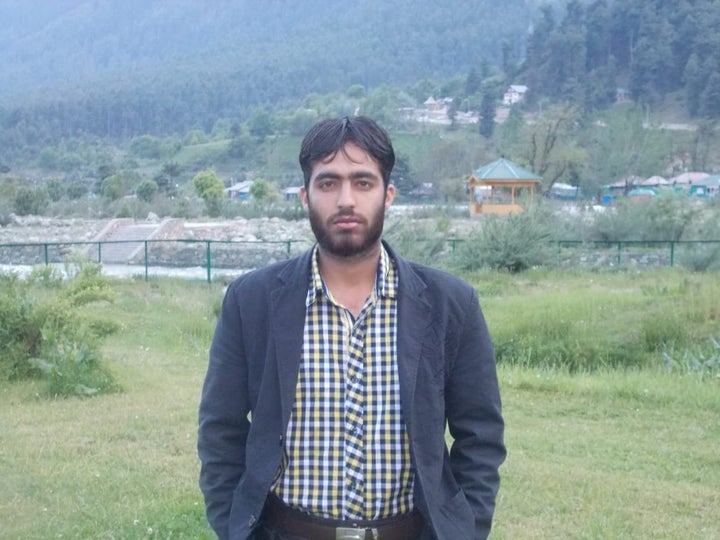
SRINAGAR, Jammu and Kashmir ― Clad in a long woollen cloak with a white cloth draped loosely over her head, soft-spoken Sarwa Begum described how her heart skipped a beat when she heard her son Saifullah Mir was the new chief of the Hizbul Mujahideen, a militant organisation born in Jammu and Kashmir in 1990 with the goal of merging Kashmir with Pakistan.
It was a windy evening on 11 May, with Kashmir’s five-month long winter in full retreat, when Sarwa Begum heard the news from her neighbour. The 55-year-old woman, who had just finished her household chores for the day, knew then that she would spend every waking moment of the rest of her life tormented by the inevitability of her son’s fate.
In a recent video call with HuffPost India from Malangpora village, Sarwa Begum said she had not seen her son since August 2014, when he left to join the militant movement that has been raging in the bloodied yet stunningly beautiful Kashmir Valley for 30 years. She lies awake night after night, consumed by dread and anxiety.
In the hour-long video call over 2G network, the only kind allowed after the Narendra Modi government blocked the internet in J&K for six months, Sarwa Begum said that she did not understand why her son, who had garnered respect and accolades for his expertise in repairing medical equipment, chose to join the militancy.
His neighbours in separate conversations with HuffPost India described him as quiet, religious and, unlike one of his hugely popular predecessors Burhan Wani, not a big fan of social media. But he is like so many of his generation, they said, “a child of conflict” born into a never-ending cycle of violence.
Officials preparing background information on Mir say that sustained encounters by Indian security forces have “thinned out” the ranks of the HM, and its new chief—one of the top ten most wanted militants in 2019—would be preoccupied with guarding and growing its existing cadre.
“I protected my children under my wings like a hen does her chicks. I didn’t know he would run away like this,” said Sarwa Begum, a mother to five children. “He wanted to be a doctor. He said he would help people. He didn’t become one but went into the medical line nevertheless. Then, he suddenly picked up the gun.”
““I protected my children under my wings like a hen does her chicks. I didn’t know he would run away like this.”
Fourth from Pulwama in five years
Mir, 31, was appointed the new HM chief five days after his predecessor Riyaz Naikoo, 35, was shot dead by the Indian Army in an encounter at his native village Beighpora, five kilometres from Mir’s village of Malangpora in district Pulwama, the nerve centre of HM’s operations in Kashmir since the advent in 2015 of Burhan Wani. Wani, the first social media savvy-chief of the outfit who also revived the moribund militant movement in Kashmir, was killed in an encounter in 2016.
A statement from the head of the HM in Pakistan, Syed Salahuddin, which was published by Kashmir News Service on 10 May, referred to Mir by his moniker Gazi Haider and said that he was appointed the militant outfit’s chief operational commander in J&K. Mir’s appointment was reported by several Indian media organisations and confirmed by sources in the J&K Police to HuffPost India.
The HM was designated a terrorist organisation by India in 1990 when it was established, the European Union in 2005, and the United States in 2017.
The J&K Police says the HM has killed Indian security forces personnel, village heads, and civilians it sees as sympathetic to India. In August 2018, it claimed responsibility for the abduction of the families of Kashmiri policemen in response to detention of relatives of militants. In January 2016, the outfit also claimed responsibility for the Pathankot airbase attack, even though India blamed another militant outfit, Jaish-e-Mohammed, for the strike that left seven soldiers and six militants dead. Following the deadly attack claimed by Jaish-e-Mohammad on an Indian army camp that left 40 paramilitary troopers dead in Pulwama in February, 2019, Naikoo had threatened to carry out more such strikes. This week, the J&K Police say they found a car filled with explosives belonging to a HM member named Hidayatullah Malik, intended for another attack similar to the one in Pulwama last year.
Mir is the fourth operational chief of HM from Pulwama since 22-year-old Wani was killed in July 2016, triggering a six-month long unrest that left many Kashmiris dead, injured and blinded from pellet gun injuries.
Wani was succeeded by 25-year-old Zakir Musa, who soon fell out with the outfit’s Pakistan-based leadership after trying to align the militancy in Kashmir with a pan-Islamist worldview. Musa later quit the HM and set up Kashmir’s first Al-Qaeda-affiliated outfit, Ansar Gazwat-ul-Hind, in July 2017. He was killed in an encounter with security forces personnel in Pulwama in May 2019.
Naikoo succeeded Musa and, in his three years at the helm, ensured that the HM was not taken over by Al Qaeda.
“Pulwama has been the stronghold of HM since 2015 when Burhan Wani drew more youth to militancy. Later, militancy radiated from Pulwama to other districts in South Kashmir,” said a senior police official in Jammu and Kashmir Police, who was posted in Pulwama last year, speaking on the condition of anonymity. “This probably gives Pulwama a certain centrality in the Hizbul (Mujahideen) scheme of things”.

Who is Mir?
Mir, the son of a government school teacher, with three brothers and a younger sister, grew up in Malangpora, a village ringed in by orchards, and wedged between an Indian Air Force station and the railway line in Pulwama.
Mir, who studied till class 10 before earning a diploma in medical electronics from the Industrial Training Institute in Pulwama in 2010, and then another one at the National Institute of Electronics and Information Technology in Srinagar in 2013, had come to be regarded as somewhat of a “healthcare professional” in his village and was even dubbed “doctor”, his 42-year-old paternal uncle Shabbir Ahmed Mir, who lives in Malangpora, told HuffPost India.
Mir proved to be a quick learner and became so proficient in mending diagnostic equipment that after completing his course he was hired as a trainer at the institute in Srinagar, going to major hospitals to repair faulty medical machinery. He even worked for two months at the Sher-i-Kashmir Institute of Medical Sciences, Kashmir’s reputed tertiary healthcare institution, his uncle said over a video call from his village.
“He was sought by hospitals for his expertise,” he said. “We were happy that he was doing well for himself.”
In April 2014, just four months before he disappeared from his village, Mir was conferred with a certificate of excellence by J&K’s then Science and Technology minister Feroz Ahmad Khan.
Khan told HuffPost India that he didn’t recall the event as it had happened a long time ago. Mir’s family, however, has preserved the photograph of the award ceremony showing Mir receiving the certificate.
It was around the same time, sources in the J&K police said, that militants in his area would seek Mir’s help when they fell sick.
“He would use his working knowledge of medicine picked up in the course of his work in healthcare institutions to treat militants or arrange an expert help for them,” a second police officer, who has also collected background information on Mir, and who is part of counter-insurgency operations based in Srinagar, told HuffPost India.
“He was sought by hospitals for his expertise. We were happy that he was doing well for himself.”
An altered landscape
Mir has become the chief of the HM at a time when militancy in Kashmir is operating under an altered political context. The Modi government’s revocation of Article 370, which had granted J&K an autonomous status under India’s Constitution, on 5 August, and its demotion from India’s only Muslim majority state to a Union Territory last year, transformed the nature of the conflict in the region and between India and Pakistan.
“The August 5 move has created factors. Delhi has since drastically narrowed the space for a political or social struggle,” said Gull Wani, a political science professor at Kashmir University. “This has by default made militancy the only possible form of resistance against the status quo”.
According to the South Asian Terrorism Portal, run by the Delhi-based Institute for Conflict Management, since January to May 30, 2020, 86 militants, 29 security force personnel and 10 civilians have been killed in Kashmir in 52 incidents of violence. Militancy has been on an upward trend over the past five years with 175 killings of militants, civilians and security forces in 2015, 267 in 2017, 357 in 2017 and 452 in 2018 which turned out to be the most violent year in a decade. In 2019, with 283 killings, the violence subsided after the Kashmir Valley was placed under lockdown in August, followed by the onset of winter.
This year, after an eight-month relative decline in casualties, there has been a spike since April. Seventy two people including 44 militants and 23 security forces personnel have died in the past two months.
“There is an obvious attempt to scale up the militancy,” said the second police officer, speaking on condition of anonymity. “But we had anticipated it and we are prepared.”
“There is an obvious attempt to scale up the militancy.”

Joining the militancy
While his family believed Mir to be looking at a promising career as a medical equipment technician in Srinagar, the militancy was creeping back in South Kashmir after Burhan Wani’s social media campaign to recruit young men. The pictures and videos of Wani and other young men in army fatigues and Kalashnikovs swung over their shoulders made the militancy seem like a glamorous pursuit to many.
Mir, his uncle said, disappeared from their village on 10 August, 2014.
“It was the third day of Bakra Eid. He was distributing sacrificial meat. That day he left home early in the morning and didn’t return,” his uncle said. “We filed a missing report with the police. It was the police that later told us he had become a militant”.
What drove him to militancy? His family is still searching for answers.
“What drove him to militancy? His family is still searching for answers.”
In the case of Burhan Wani, the story goes that he was harassed by Indian security forces personnel when he was in class 10, and his elder brother Khalid was beaten up by them. If there was a trigger for Mir picking up a gun, his family members say they don’t know. To the best of their knowledge, he had no violent encounter with the security forces.
“Security forces had never entered our house. There was never any incident,” said Sarwa Begum, Mir’s mother. “They came after my son became militant but they didn’t misbehave.”
Mir, she continued, was the dearest child in the family. “He was everyone’s darling. And he was devoted to me and his father,” she said.
“Security forces had never entered our house. There was never any incident.”
Unlike Wani, who had wielded social media to promote himself and the HM in Kashmir, a neighbour from Malangpora village, speaking on the condition of anonymity, described Mir as a “modest, introverted” guy, not particularly into social media.
“He is reticent, wouldn’t talk much,” this neighbour said in a phone conversation.
‘A child of conflict’
While the official estimate of people killed in J&K since the militancy started in 1990 is 42,000, the Coalition of Civil Society, a human rights group based in Srinagar, puts the death toll at 70,000.
A second neighbour, who spoke on the condition of anonymity, said a militant from the village, Parvez Ahmad, who was killed in 2010, was Mir’s friend.
“Besides, the three summers of unrest till 2010 that killed around 200 people registered on his mind,” said this neighbour, in a phone conversation. “He was a sensitive boy and very religious also. All these events played a role.”
This neighbour called Mir “a child of conflict,” since he was born in 1989, the year when the militancy began in Kashmir. “His age is the age of the conflict in the Kashmir Valley. All that he has witnessed is killings, killings and killings,” he said.
“His age is the age of the conflict in the Valley.”
Inside Hizbul Mujahideen
After joining the militancy, Mir is believed to have become close to Riyaz Naikoo, who succeeded Wani as the HM chief in 2017, the second police officer, who has gathered background information on him, told HuffPost India.
According to this officer, Wani had worked for sometime as Naikoo’s overground worker, before joining the militant outfit formally. (Overground workers arrange logistical support and shelter for the militants but do not participate in combat).
“He is not from the Burhan group. He is not among the 11 slain militants who were a part of the viral group photo with Burhan,” said this police officer. “Nor, like most militants from South Kashmir, is he trained in Pakistan.”
While Wani hailed from Tral, a town 25 km away from Mir’s Malangpora, Naikoo was from the neighbouring village of Beighpora.
This police officer believes it is Mir’s closeness to Naikoo that gave him an edge over others in the selection for the new HM chief including Mohammad Ashraf Khan, a 48-year-old militant from Anantnag district.
“Mir has been groomed by Naikoo and hence he is the new chief,” he said.
Road ahead
HM continues to retain its relevance and identity as an indigenous outfit, people in Kashmir believe, but police and intelligence officials say the outfit has lost a significant number of its recruits this year.
The second police officer in Srinagar said that most of the 80 militants killed in Kashmir by Indian security forces since January were from HM’s stronghold in South Kashmir. While estimating the number of militants in Kashmir to be around 250, this police officer said the killings have “thinned out the outfit’s ranks.” “And at the current rate of killings, there should be no militancy at the end of the year in the absence of a simultaneous replenishment,” he said.
Mir, this police officer added, would most likely remain preoccupied with recruiting more young men to the HM ranks and saving its existing cadre.
A WhatsApp message, which was recently circulated in Kashmir, says that Mir has asked his cadre members to turn off their mobile phones to prevent Indian intelligence agencies from tracking them down. The WhatsApp forward was also quoted by widely cited Twitter handle Kashmir Intel. HuffPost India cannot verify the authenticity of this message.
For Sarwa Begum, however, militancy doesn’t mean much beyond losing her son. “My health has failed since he left. I take antihypertensive drugs to keep myself going,” she said.
When asked if she wanted Mir to return home, his mother did not give a direct answer. “When any mujahid (holy warrior) dies in the neighbourhood, I don’t visit the family. I can’t bring myself to,” she said.
For the latest news and more, follow HuffPost India on Twitter, Facebook, and subscribe to our newsletter.